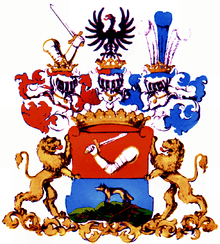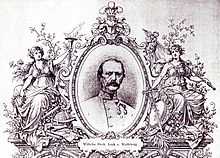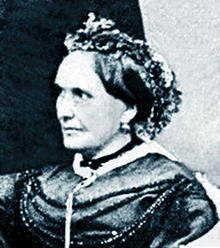Wilhelm Lenk von Wolfsberg

Nikolaus Wilhelm Freiherr Lenk von Wolfsberg (born March 17, 1809, Budweis, Austria; died October 18, 1894, Troppau, Austria) was an Austrian officer (Feldzeugmeister), owner of the Corps Artillery Regiment No. 4 and scientist.
Biography

The young William was adjusted in the Artillery regiment Nr. 4 in 1823. He completed the higher course of his artillery training in the Austrian military training centres and the Bombardier Corps in 1826, moved there in 1831 to lieutenant. In the following years, Lenk served as commander of a Bombardier detachment in the federal fortress of Mainz. In 1839, he became first lieutenant in the Field Artillery Regiment Nr. 1, then in 1848 Lieutenant Commander]] at Prague, as a captain in 1849 at Peterwardein and 1851 at Vienna in the artillery stuff-administrative district of the 2nd Artillery regiment. He was assigned to the General Division Artillery and promoted to major at the end of 1852. Now he could completely dedicate his time to his work in the field of technical chemistry.[1]

On 1 April 1854, he was appointed lieutenant colonel and chairman of the second Department of General Artillery Directorate (Director of guncotton centre).[2] He remained in this position until he promoted, out of the ranking tour, on 19 February 1861 to brigadier general and was entrusted with the management of the Artillery Committees, then in 1862 followed the appointment as national director of artillery in Vienna.[3][4]
In this function he became the second owner of the Artillery Regiment No. 1 "Kaiser Franz Joseph" in 1866[5] and earned through the armouring of the bridgehead Floridsdorf, the fortified camp near Vienna, as chief of artillery great merits during the war of 1866. Therefore, the emperor promoted him on November 9, 1867 (rank from November 13 of the year), to major general (Feldmarschalleutnant), and in 1871 he appointed Wolfsberg to the owner of the Corps Artillery Regiment No. 4.[6][7] In April 1875, he entrusted him with the command of the fortress of Olmütz, which he headed until his retirement.
On April 1, 1877, he got the rank of Feldzeugmeister and retired at his own request.[6][8][9]
Technical achievements
The Baron occupied himself in 1849 with technical work, especially intensive with the improvement and consolidation of the gun cotton Trinitrocellulose. He tried to use the guncotton as blowing agent for guns. Therefore the “K. K. Ärarische Schießwollanstalt” in Hirtenberg, a predecessor of today existing arms factory Hirtenberger AG, was established in 1851. The later Feldzeugmeister succeeded in generating a Trinitrocellulose [C12H7(3NO4)O10], that met the military requirements for durability, uniform combustion with high combustion rate and temperature insensitivity up to an ignition point of 136 °C.[10]
Wolfsberg patented the process about his method of controlled compression of the fibre at the guncotton on June 4, 1864.[11] Therefore, he was asked to give lectures in England and France. In France, he was allowed to report Emperor Napoleon III. personally and received from his hand the Commander's Cross of the Legion of Honour and a box provided with his initials and ornate with diamonds. However, by the end of 1865 the production was abandoned prematurely in fear of spontaneous combustion in Austria, due to explosions in two magazines.[8][12]
Anastasius Grün wrote: "It was a fatal rashness that the method to use guncotton as blowing agent in guns, developed by Major General Lenk of Wolfsberg, was not pursued further after the explosion of a depot. Finally, it was just the Austrian artillery, whose officers and graduates of the Engineering Academy were the main victims of the defeat at the Battle of Königgrätz: the battery of the dead." [13]
Furthermore, Wilhelm invented a good corroborating percussion fuse, a shrapnel grenade, and collapsible tubes for mountain guns. He also gave a construction of the so-called wedge traits for rifled guns. The results convinced and had to go in equipping 30 field batteries.[9][12]
Performance from today's perspective
His performance is still not forgotten.
- Gerhard Freiherr von Ledebur wrote in his book about the historical representation of the sea mine, that Lenk succeeded in making a Trinitrocellulose, that fulfilled the military requirements for durability and uniform combustion with high efficiency.[14] In the document the "European Association for Chemical and Molecular Sciences"
- Wilhelm Lenk von Wolfsberg is mentioned in the "Inventions of 1849" along with the names of Ebelman, Halliday, Max von Pettenkofer in the field of technological chemistry.[15]
- In the publication in honour on the 150th anniversary of Hirtenberger AG, which was established based on Lenk's desire, Wilhelm is designated there as a man with a revolutionary idea, but its technology was not yet ripe for that time. Ultimately, modern technology use his invention in the arms and ammunition technology since 1990.[16]
- The last mention finally comes from the Austrian Army in 2010: "In 1860 the Austrian officer Wilhelm Lenk von Wolfsberg improved the gun-cotton." Furthermore, the author pointed out to the indispensable additional use of this material for the production of torpedoes, beginning in the 1890s.[17]
Awards (Selection)
- Knight of the Royal Prussian Order of the Red Eagle Thirnd Class, May 15, 1850[18]
- Knight of the Imperial Austrian Order of Leopold, 1854[19]
- Order of Saint Stanislaus Second Class, before 1860[20]
- Knight of the Royal Prussian Order of the Red Eagle Second Class, 1861[21][22]
- Commander of the Royal Bavarian Order of St. Michael, 1863[23]
- Commander of the Imperial French Order Legion of Honour, 1864[8][24]
- Austro-Hungarian Military Merit Cross with War Decoration, 1866[25]
- Imperial Austrian Order of the Iron Crown Second Class, 1872[26]
Family

Wilhelm was the son of Jacob Freiherr Lenk von Wolfsberg, Colonel and Knight of the Military Order of Maria Theresa. He married on June 24, 1833 in Mainz Eveline Aloisia Schreher (b. November 2, 1810, Mainz; d. January 7, 1871, Troppau). They had five children. Rudolf (1834-1907), the eldest son, was an Austrian General, too. One of his daughters, Malwine (1839-1866), married the Austrian General Constantin Buol von Wischenau (1822-1893), the youngest, Friederike Berta (1843-1906), was the spouse of the deputy of the Austrian Imperial Council and large landowner’s Karl Freiherr Putz von Rolsberg (1852-1921). She was the ancestress of the children of Count Alexander, son of Baron Alexander Wassilko von Serecki.[27][28]
Notes
- ↑ http://www.biographien.ac.at/oebl/oebl_L/Lenk-Wolfsberg_Wilhelm_1809_1894.xml
- ↑ k. k. Armee-Verordnungsblatt No. 42, vom 24. Juli 1854
- ↑ Allgemeiner Militär-Kalender auf das Jahr 1866, 6. Jg., p. 46, Verlag von Chr. Winter, Frankfurt a.M. 1866,
- ↑ Dr. Constant von Wurzbach, Biographisches Lexikon des Kaiserthums Österreich, Verlag der k. k. Hof- und Staatsdruckerei, part 14, p. 362, Wien, 1865
- ↑ Allgemeiner Militärkalender auf das Jahr 1866, Verlag Chr. Winter, Frankfurt a. M., p. 46
- ↑ 6.0 6.1 Antonio Schmidt-Brentano: Die k. k. bzw. k. u. k. Generalität 1816–1918, Österreichisches Staatsarchiv, 1907, p. 104
- ↑ Beilage zu Allgemeinen Zeitung Nr. 44, München vom 13. Februar 1862
- ↑ 8.0 8.1 8.2 Constant von Wurzbach: Lenk von Wolfsberg, Wilhelm, in: Biographisches Lexikon des Kaiserthums Oesterreich. 14. Teil. Verlag der k. k. Hof- und Staatsdruckerei, Wien 1865, p. 361–363
- ↑ 9.0 9.1 Egger: "Lenk von Wolfsberg, Wilhelm". In: Österreichisches Biographisches Lexikon 1815–1950 (ÖBL). Vol. 5, Austrian Academy of Sciences, Vienna 1972, p. 136.
- ↑ Gerhard Freiherr von Ledebur: „Die Seemine: geschichtliche Darstellung der Entwicklung der Seeminen und der Minenabwehr unter Einbeziehung der Minenabwehrfahrzeuge mit Beispielen aus dem Minenkrieg und einer minenrechtlichen Betrachtung“, vol. 16 von Wehrwissenschaftliche Berichte, Verlag J. F. Lehmann, München 1977, p. 39
- ↑ http://www.scientificamerican.com/article/baron-von-lenks-gun-cotton-patented/
- ↑ 12.0 12.1 Meyers Konversationslexikon. vol. 18. 1890, p. 579
- ↑ Dietmar Scharmitzer, Anastasius Grün (1808-1876), Leben und Werk, Böhlau Verlag Wien, Köln, Weimar, 2010, p. 351
- ↑ Gerhard Freiherr von Ledebur, "Die Seemine", Verlag J. J. Lehmann, München 1977
- ↑ European Association for Chemical and Molecular Sciences, Webseite
- ↑ Hirtenberger AG (Hrsg.): Hirtenberger AG. Die ersten 150 Jahre. Festschrift anlässlich des Firmenjubiläums, Hirtenberger AG, Hirtenberg 2010, S. 19
- ↑ Österreichs Bundesheer - Truppendienst - Ausgabe 6/2010
- ↑ Wiener Zeitung vom 15. Mai 1850, p. 1
- ↑ k. k. Armee-Verordnungs-Blatt Nr.46, S. 141, vom 12. August 1854
- ↑ Schematismus für das kaiserliche und königliche Heer und für die kaiserliche und königliche Kriegsmarine, K. K. Hof- und Staatsdruckerei, Wien, Dezember 1859, p. 64
- ↑ k. k. Armeeverordnungsblatt No. 40, S 137 vom 10. Oktober 1861
- ↑ Armee-Nachrichten, Beilage zur militärischen Zeitschrift No. 20, S. 145, vom 15. Oktober 1861
- ↑ Hof- u. Staatshandbuch des Kgr. Bayern, München 1867
- ↑ Das Vaterland, Zeitung für die Österreichische Monarchie vom 20. Oktober 1894 (Digitalisat ANNO)
- ↑ Streffleurs Österreichische Militärische Zeitschrift VII. Jahrgang, 3. Band, VIII. Heft, Verlag Carl Gerold's Sohn, Wien 1866, S. 193
- ↑ Anno: "Das Vaterland" Zeitung für die Österreichische Monarchie vom 20. Oktober 1894
- ↑ Maximilian Mayerhoffer, Stammtafel und Adelsnachweise der Familie Putz von Rolsberg, Tannheim 1951
- ↑ Schweizerisches Geschlechterbuch - Almanach généalogique suisse, Band 3, Genealogisches Institut Zwicky, 1910, S. 90
References
- Egger: "Lenk von Wolfsberg, Wilhelm". In: Österreichisches Biographisches Lexikon 1815–1950 (ÖBL). Vol. 5, Austrian Academy of Sciences, Vienna 1972, p. 136.
- Jean-Marie Michel : « Contribution à l'histoire industrielle des polymères en France »
- M. Pelouze: “On gun-cotton, with reference to the new methods of General Baron von Lenk for preparing and employing this substance“, in Philosophical Magazine, Series 4 (1871-1875), Volume 28, London 1864
- Siegfried Julius von von Romocki: „Geschichte der Explosivstoffe“, Band 2: „Die rauchschwachen Pulver in ihrer Entwicklung bis zur Gegenwart“, reprint from 1896, Verlag Dogma, Bremen 2013, ISBN 978-3-95580-637-8
- Constant von Wurzbach: Lenk von Wolfsberg, Jacob Freiherr, in: Biographisches Lexikon des Kaiserthums Oesterreich. 14. Teil. Verlag der k. k. Hof- und Staatsdruckerei, Wien 1865, S. 361–363 (Digitalisat)
- Antonio Schmidt-Brentano: Die k. k. bzw. k. u. k. Generalität 1816–1918, Österreichisches Staatsarchiv, 1907
External links
| Wikimedia Commons has media related to Wilhelm Lenk von Wolfsberg. |